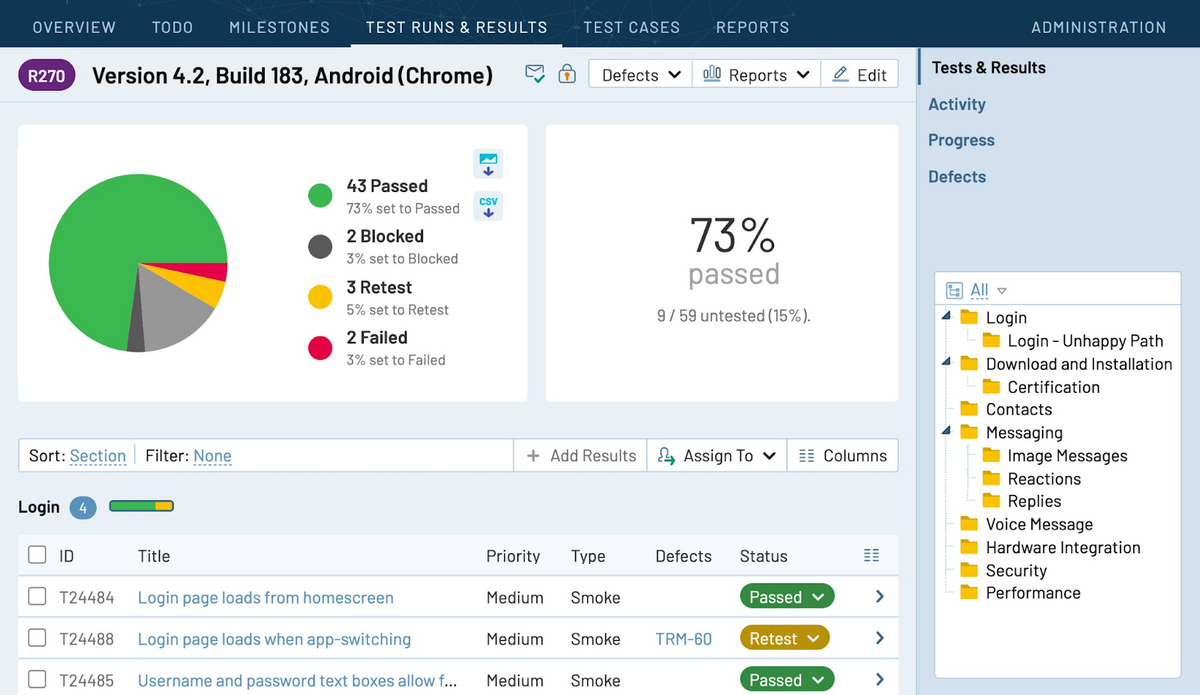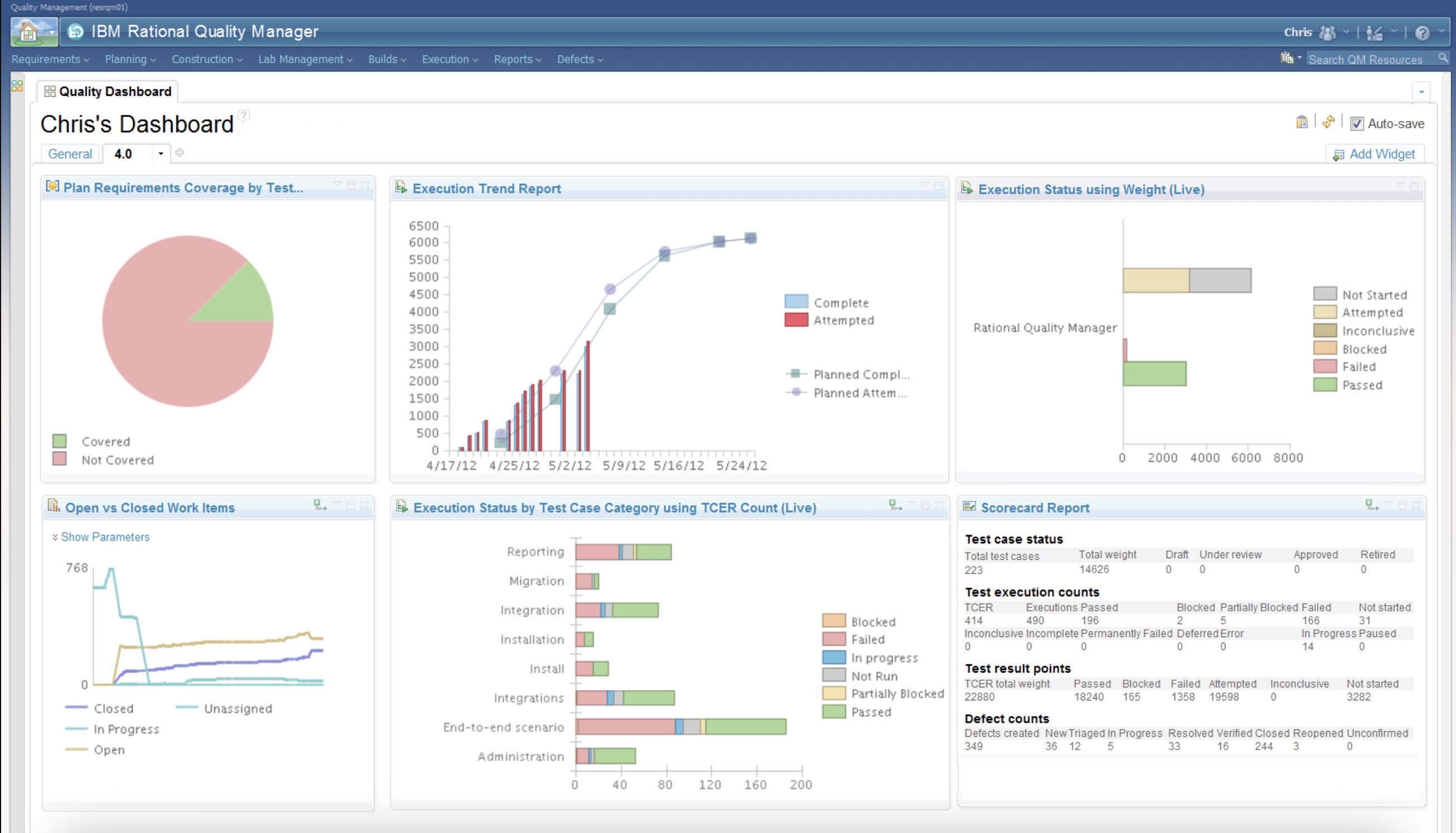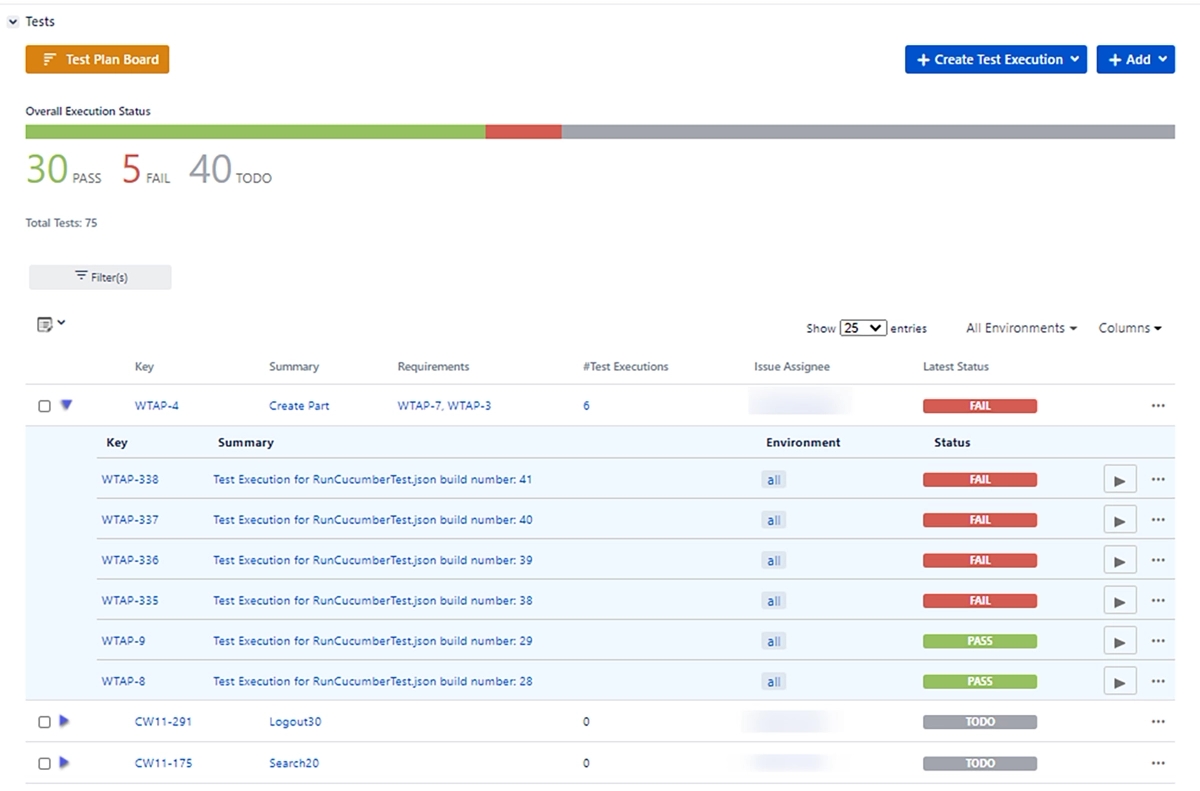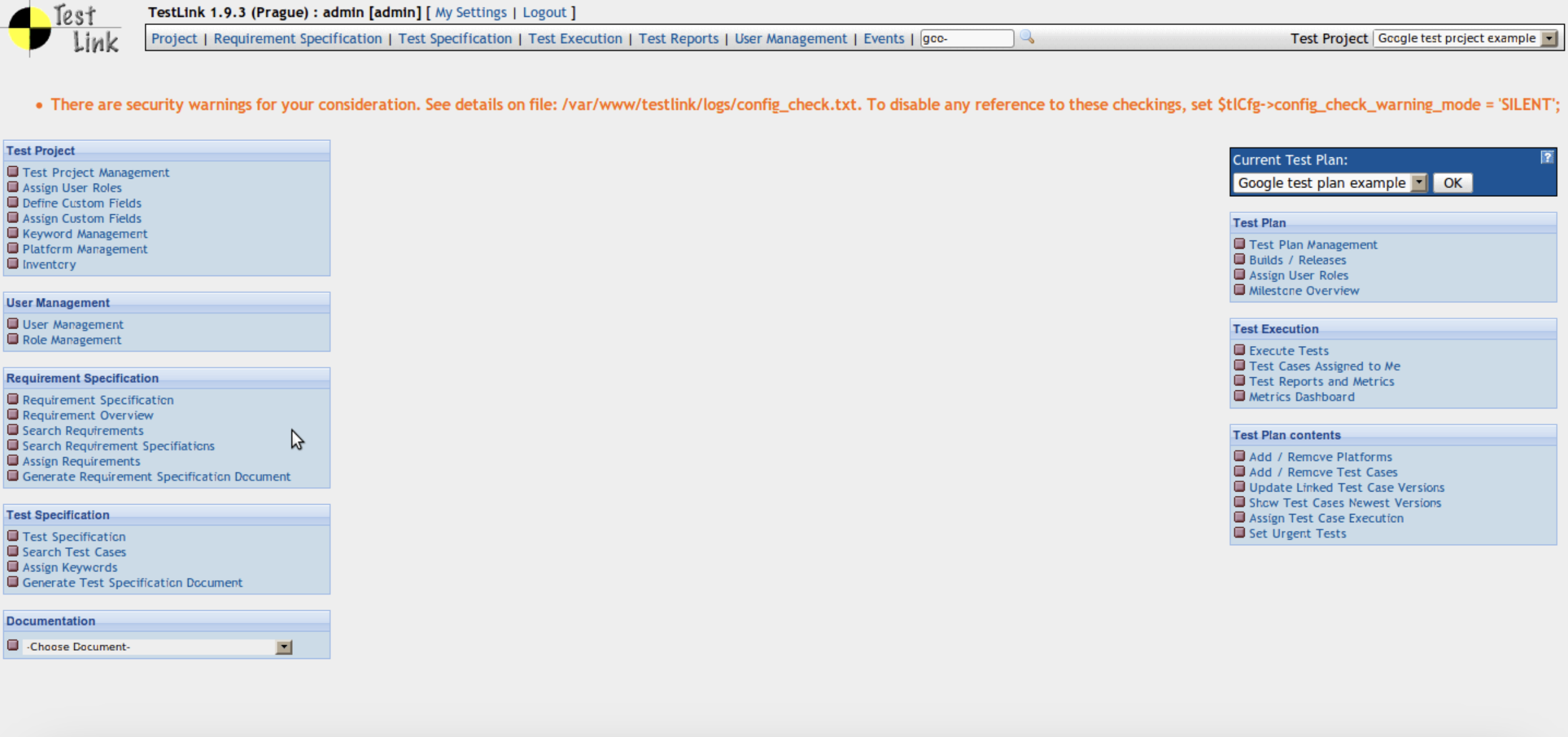Top 5 Test Management Tools for 2025
|
|
This article mentions the top 5 test management tools of 2025 (not in any particular order). You can go through the features curated below for each of them. Choose what suits your project and team’s needs the best.
TestRail

TestRail provides a centralized test management system to manage all your testing activities in one place. The key strength of TestRail is its user-friendly interface to help both individual testers and large-scale testing at ease. Below are the prominent features of TestRail:
Test Management
A centralized test repository lets you manage, organize, and track the test cases. Create custom fields, such as a dropdown menu, to select the automation status of a test case. Import test cases or quick-add test cases by providing a few details. Create your own test case template or use the existing templates. Access test history such as who executed the test, who modified it, comments, etc. Get coverage reports related to test coverage, defect slippage, etc. Test case approval processes can be set up to be thoroughly reviewed and executed.
Planning and Collaboration
Test runs and plans let you organize and execute specific tests and group runs, assign them to team members, and record results. Milestones define testing goals and timelines. To-do lists keep teams on track with centralized tasks. Test parameterization manages data for varied test scenarios. Estimates and forecasting predict timeframes for completing testing milestones.
Test Automation and Integrations
Provides defect-requirement, test automation, and CI/CD integrations. The TestRail API and CLI offer advanced manipulation of test entities. Webhooks trigger outbound requests for testing events. Test automation triggers enable custom UI functionalities. Centralized reporting aggregates test results from multiple DevOps tools for comprehensive analysis.
Test Tracking and Traceability
Workflows in test management streamline testing with features like a three-pane view for easy navigation. Result logging includes detailed test steps, times, and environmental data, with attachment uploads for context. You can also link and push defects to tools like Jira for quick reporting.
You can maintain the test traceability by linking test artifacts to requirements and defects. You can clone test runs and plans for reruns without reconfiguration. These results preserve historical data and prevent alterations.
Reporting Features and Security
Use test metrics, live dashboards, and cross-project reporting for an excellent reporting experience. You can share reports, generate automatic reports, and customize the dashboard charts.
Security is maintained in TestRail through MFA, access control, SSO, audit logs, custom roles, etc.
Integrate TestRail with testRigor, which is an intelligent AI-based automation testing tool. This intelligent tool helps you achieve your testing goals faster with the least effort.
Summary: Ideal for QA and development teams of any size that require an all-in-one test management solution with extensive integration options. It is suitable for both agile and waterfall methodologies, providing customizable dashboards, planning, execution, tracking, and reporting capabilities. Organizations looking for a tool that supports both manual and automated testing will find TestRail particularly useful.
Zephyr

Zephyr is equipped with all the test management requirements that you need, from integrations, DevOps, and Agile to collaboration to shift-left or continuous testing. They have different solutions based on your needs and team size, providing complete lifecycle management.
You can choose from the available Zephyr solutions based on your team size:
Zephyr Squad (Small Agile Teams)
It is an easy-to-use, flexible test management solution inside Jira that helps you manage your requirements in Jira, execute tests, and create reports. Integration with CI/CD and other tools is easily available. If you are working with an Excel sheet or just Jira, this is an excellent switch to help your small Agile team deliver faster and more efficiently.
Zephy Scale (Mid-sized Teams)
A more structured test management solution for your mid-sized team where you are using some test management legacy tool. If you are looking for test scalability and reusability for your tests and advanced reports, this is a good option.
Zephyr Enterprise (Large Complex Teams)
This is worth trying if you have a large organization where security and compliance are essential, and teams work in diverse Agile and Waterfall environments. Provides expansive support for automation frameworks to aggregate reporting on test activities throughout the organization.
Directly link your Zephyr test cases to testRigor and automatically create test runs. Read more.
Summary: Zephyr caters to teams of different sizes with its tiered solutions: Zephyr Squad for small Agile teams, Zephyr Scale for mid-sized teams, and Zephyr Enterprise for large organizations. It’s highly versatile, supporting integration with CI/CD tools, agile and waterfall methodologies, and providing complete lifecycle management. Companies looking for a scalable test management tool that offers solutions tailored to team size and needs should consider Zephyr.
IBM Rational Quality Manager

The major highlight of using IBM Rational Quality Manager (IBM RQM) is collaboration with distributed teams, which makes it easy to share information with other team members.
It is a collaborative, web-based tool for planning, constructing, managing, and executing tests throughout the development lifecycle. It supports test teams of all sizes and handles various user roles, such as test manager, test architect, test lead, tester, and lab manager. Below are the distinctive features:
Expansive Test Planning and Design
Navigate through all project phases, and you can define test plans that outline objectives, scope, criteria, and process reviews. It supports managing project requirements and test cases, estimating test efforts, scheduling test iterations, and listing various test environments.
The tool’s design and construction features include a rich-text editor for detailed background information on each test case. It allows linking test cases to development items, requirements, and other test artifacts, such as test plans and scripts.
Test Script Creation, Execution, and Reuse
RQM provides a manual test editor and supports adding reuse and automation capabilities to manual tests using keywords. RQM includes an integrated test environment for running tests developed within the product or other testing tools.
Test Analysis, Reporting, and Live Views
It offers predefined BIRT (Business Intelligence and Reporting) reports and Jazz Reporting Service for cross-project test management. Live execution status can be viewed in test plans, and traceability across test artifacts and requirements is facilitated.
Configuration Management
With configuration management capabilities, RQM allows for versioning of test artifacts, linking them to other team artifacts, and managing reuse and traceability. It supports configurations for managing different software versions or variants.
Team Collaboration
RQM enhances information sharing among team members to help with task and defect assignment, review tracking, and visibility of requirements and corresponding test cases. It also features artifact locking to prevent unauthorized edits.
Lab Management
Rational Quality Manager aids in lab management by facilitating requests for test environments specified in test plans. Lab managers can manage resources and service requests efficiently.
Summary: Designed for teams looking for a collaborative, web-based tool that supports distributed teams and complex project environments. RQM is well-suited for organizations that need expansive test planning and design capabilities, test script creation, execution, reuse, and detailed reporting. It’s particularly beneficial for large teams or projects that require extensive collaboration and integration capabilities across the development lifecycle.
Xray

Xray is a test management tool that provides Jira-native experience in managing testing artifacts. Xray’s powerful REST API, integrations, and reporting seamlessly integrate into the CI/CD pipeline. It supports native integration into leading testing automation frameworks and supports testing your web, mobile, and desktop applications with Xray and Jira integrations.
You can link your requirements to test cases, create detailed traceability reports, get native BDD support, and have easy integrations with Xray. Below are the features:
Jira Native Integration
Xray’s native integration with Jira lets you manage test cases, plans, and executions within the familiar Jira interface. This makes traceability between test cases and other Jira issues like user stories, tasks, and bugs easily manageable.
Test Planning and Organization
You can create, organize, and manage test cases and suites for various testing methodologies, including Agile and traditional approaches. Here is a test plan template.
Combine Manual and Automated Testing
Xray is versatile and supports both manual and automated tests. It can integrate with significant automation frameworks and let you manage them alongside manual test outcomes. Read here what test should you automate first.
Customize Reports and Dashboards
Use customizable reports and dashboards that provide insightful metrics and statistics about the testing process. This feature aids in decision-making and confirms that stakeholders are well-informed about the test progress and quality.
Use CI/CD Integration
Xray supports integration with CI/CD pipelines, enhancing its utility in DevOps environments. This allows for smooth automated test execution and reporting as part of the CI/CD process.
Automatically link your test cases to testRigor and generate test runs in Xray Cloud each time your tests are executed – Read more.
Summary: Perfect for teams already using Jira for issue tracking and project management, who seek seamless integration for their test management processes. Xray utilizes Jira’s native issue types, making it an excellent choice for organizations that prefer to keep all project-related activities within the Jira ecosystem. Its support for manual and automated testing and robust reporting capabilities make Xray a strong candidate for agile teams focused on efficiency and transparency.
TestLink

If you are interested in an open-source test management tool, your search ends at TestLink, which is the most popular of the lot. As a web-based tool, it offers a centralized platform for test teams to collaborate and maintain various aspects of the testing lifecycle.
Below are the valuable features of TestLink:
Systematic Test Management
You can create and manage test projects and specify test plans, cases, and suites systematically using TestLink. It helps to define and structure your testing process in tandem with project requirements.
Quick Integration with Issue Tracking Systems
TestLink is a standalone tool that can easily integrate with popular bug-tracking systems. Aids in efficient defect tracking and management for a smooth workflow between testing and issue resolution.
Requirement Traceability
Link test cases to specific requirements so that tests cover all needs to enhance the quality assurance process and have requirement traceability. Read here about test traceability and its importance in detail. Read: Requirement Traceability Matrix RTM: Is it Still Relevant?
Create Custom Reporting and Metrics
Generate detailed reports on test execution, results, and coverage. These reports are required for tracking progress and identifying areas that need attention. Read about test reports and everything you need to know.
User Roles and Permissions
The tool supports different user roles and permissions for controlled access and management of test artifacts. This feature is handy for large teams with varying levels of responsibilities.
Test Execution and Results Recording
With TestLink, you can execute the test cases and have a recording of the test results. Perform manual execution; see logged results to get a clear overview of test outcomes. Here is a test log tutorial.
Community Support
Being open-source, TestLink benefits from strong community support. Many forums and resources are available for troubleshooting and help.
Summary: Best for teams seeking an open-source, cost-effective test management solution. It offers a centralized platform for managing various aspects of the testing lifecycle, including test planning, execution, and reporting. TestLink is suitable for teams that prioritize flexibility and integration with issue-tracking systems. If you require a tool that supports systematic test management without the financial overhead of paid solutions, TestLink is the solution for you.
Conclusion
Test management tools are essential for managing and completing testing activities successfully. Many are available in the market, including open-source, freemium, and paid ones. Every tool has its own strong capability, and the choice depends on the project’s size, needs, and complexity.
You should go through a trial period before choosing one so that you can make an informed decision. I hope this article helps you make that decision.
| Achieve More Than 90% Test Automation | |
| Step by Step Walkthroughs and Help | |
| 14 Day Free Trial, Cancel Anytime |












